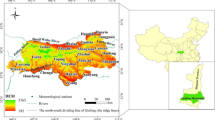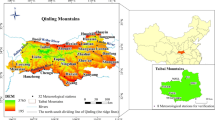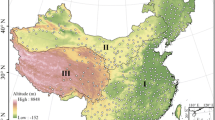Abstract
Based on daily mean temperature data from 32 meteorological stations in the Qinling Mountains (QMs) of China, we analyzed the characteristics and differences of the spatiotemporal changes in the climatic growing season (CGS) in the QMs from 1964 to 2015. Our results are as follows. First, over the past 52 years, the temperature of the QMs significantly increased at a mean rate of 0.22 °C/decade (P < 0.01) in over 98.04% of the area. Significant north–south spatial differences were observed in temperature changes; also, significant differences in the temperature changing trends were observed before and after the abrupt change in temperature. Second, the spatial distributions of the mean growing season start (GSS), end (GSE), and length (GSL) in the QMs varied based on regional differences in latitude and topography. Notably, the GSS, GSE, and GSL were gradually delayed, advanced, and shortened, respectively, as latitude and elevation increased. After the abrupt change in temperature, whether it is in the NSQM (northern slopes of the QMs) or the SSQM (southern slopes of the QMs), the GSS, GSE, and GSL expanded into high-elevation areas. Third, over the past 52 years, the GSS in the QMs exhibited a significant advancing trend of 2.7 days/decade, the GSE was delayed at a rate of 0.66 days/decade, and the GSL displayed a significant extension of 3.36 days/decade. Before the abrupt change in temperature, the GSS, GSE, and GSL exhibited non-significant changing trends; however, the trends in the GSS, GSE, and GSL were more significant after the abrupt change than before. Fourth, the GSS, GSE, and GSL trends in the QMs were significantly different in the NSQM and SSQM regions. After the abrupt change, the GSS, GSE, and GSL trends along the NSQM were more significant than those along the SSQM.








Similar content being viewed by others
References
Bai HY (2014) The response of vegetation to environmental change in Qinba Mountains. Science Press, Beijing (in Chinese)
Bai HY, Ma XP, Gao X, Hou QL (2012) Variations in January temperature and 0 °C isothermal curve in the Qinling Mountains based on DEM. Acta Geograph Sin 67(11):1443–1450 (in Chinese)
Chen XQ, Lin X (2012) Temperature controls on the spatial pattern of tree phenology in China’s temperate zone. Agric For Meteorol 154-155:195–202
Chen XQ, Xu L (2012) Phenological responses of Ulmus pumila (Siberian elm) to climate change in the temperate zone of China. Int J Biometeorol 56(4):695–706
Chmielewski FM, Rölzer T (2001) Response of tree phenology to climate change across Europe. Agric For Meteorol 108(2):101–112
Chmielewski FM, Rölzer T (2002) Annual and spatial variability of the beginning of growing season in Europe in relation to air temperature changes. Clim Res 19:257–264
Cleland EE, Chuine I, Menzel A, Mooney HA, Schwartz MD (2007) Shifting plant phenology in response to global change. Trends Ecol Evol 22(7):357–365
Dai JH, Wang HJ, Ge QS (2013) Multiple phenological responses to climate change among 42 plant species in Xi’an, China. Int J Biometeorol 57(5):749–758
Deng CH, Bai HY, Zhai DP, Gao S, Huang XY, Meng Q, He YN (2017) Variation in plant phenology in the Qinling Mountains from 1964-2015 in the context of climate change. Acta Ecol Sin 37(23):1–12 in Chinese
Ding YH, Ren GY, Zhao ZC, Xu Y, Luo Y, Li QP, Zhang J (2007) Detection, causes and projection of climate change over China: an overview of recent progress. Adv Atmos Sci 24:954–971
Gordo O, Sanz JJ (2009) Long-term temporal changes of plant phenology in the western Mediterranean. Glob Chang Biol 15(8):1930–1948
Hodges T (1991) Temperature and water stress effects on phenology. In: Hodges T (ed) Predicting crop phenology. CRC Press, Boca Raton, pp 7–13
Hopkins AD (1918) Periodical events and natural law as guides to agricultural research and practice. Mon Weather Rev 9(Suppl:1–42
IPCC (2007a) Climate change 2007: the physical science basis. Contribution of Working Group I to the Fourth Assessment Report of the Intergovernmental Panel on Climate Change. Cambridge University Press, New York, p 996
IPCC (2007b) Climate change 2007: impacts, adaptation and vulnerability. Contribution of Working Group II to the Fourth Assessment Report of the Intergovernmental Panel on Climate Change. Cambridge University Press, New York
IPCC (2013) Climate change 2013: the physical science basis. Contribution of Working Group I to the Fifth Assessment Report of the Intergovernmental Panel on Climate Change. Cambridge University Press, New York
Jeong JH, Ho CH, Linderholm HW, Jeong SJ, Chena D, Choic YS (2011) Impact of urban warming on earlier spring flowering in Korea. Int J Climatol 31:1488–1497
Jochner SC, Sparks TH, Estrella N, Menzel A (2012) The influence of altitude and urbanisation on trends and mean dates in phenology (1980-2009). Int J Biometeorol 56:387–394
Karlsen SR, Høgda KA, Wielgolaski FE, Tolvanen A, Tømmervik H, Poikolainen J, Kubin E (2009) Growing-season trends in Fennoscandia 1982–2006, determined from satellite and phenology data. Clim Res 39:275–286
Linderholm HW (2006) Growing season changes in the last century. Agric For Meteorol 137:1–14
Linderholm HW, Walther A, Chen DL (2008) Twentieth-century trends in the thermal growing season in the Greater Baltic Area. Clim Chang 87:405–419
Liu HB, Shao XM (2000) Reconstruction of early-spring temperature of Qinling Mountains using tree-ring chronologies. Acta Meteorol Sin 58(2):223–233 in Chinese
Liu BH, Henderson M, Zhang YD, Xu M (2010) Spatiotemporal change in China’s climatic growing season 1955-2000. Clim Chang 99(1–2):93–118
Melillo JM, Callaghan TV, Woodward FI, Salati E, Sinha SK (1990) Climate change: effects on ecosystems. In: Houghton JT, Jenkins GJ, Ephraums JJ (eds) Climate change—the IPCC scientific assessment. Cambridge Univercity Press, New York, pp 282–310
Menzel A (2003) Plant phenological anomalies in Germany and their relation to air temperature and NAO. Clim Chang 57:243–263
Parmesan C (2007) Influences of species, latitudes and methodologies on estimates of phenological response to global warming. Glob Chang Biol 13(9):1860–1872
Parmesan C, Yohe G (2003) A globally coherent fingerprint of climate impacts across natural systems. Nature 421:37–42
Peterson TC, Folland C, Gruza G, Hogg W, Mokssit A, Plummer N (2001) Report on the activities of the Working Group on Climate Change Detection and Related Rapporteurs 1998-2001. International CLIVAR Project Office, Southampton
Qin DH, Thomas S (2014) Highlights of the IPCC Working Group I fifth assessment report. Clim Change Res 10(1):1–6
Ren GY, Guo J, Xu MZ, Chu ZY, Zhang L, Zou XK, Li QX, Liu XN (2005) Climate changes of China’s mainland over the past half century. Acta Meteorol Sin 63(6):942–956 (in Chinese)
Ren GY, Ding YH, Zhao JC, Zheng JY, Wu TW, Tang GL, Xu Y (2012) Recent progress in studies of climate change in China. Adv Atmos Sci 29(5):958–977 in Chinese
Robeson SM (2002) Increasing growing-season length in Illinois during the 20th century. Clim Chang 52:219–238
Song YL, Linderholm HW, Chen DL, Walther A (2010) Trends of the thermal growing season in China, 1951-2007. Int J Climatol 30(1):33–43
Walther GR, Post E, Convey P, Menzel A, Parmesan C, BeeBee TJ, Fromentin JM, Hoegh-Guldberg O, Bairlein F (2002) Ecological responses to recent climate change. Nature 416(6879):389–395
Wang JY (1963) Agricultural meteorology, vol 108. Pacemaker Press, Milwaukee
Wang SP, Wang ZH, Piao SL, Fang JY (2010) Regional differences in the timing of recent air warming during the past four decades in China. Chin Sci Bull 55(16):1538–1543 in Chinese
Xu MZ, Ren GY (2004) Change in growing season over China: 1961-2000. Q J Appl Meteorol 15(3):306–312
Yue M, Xu YB (2014) Plant along the Qinling Mountains. For Humankind 2:8–25 (in Chinese)
Zhai DP, Bai HY, Qin J, Deng CH, Liu RJ, He H (2016) Temporal and spatial variability of air temperature lapse rates in Mt. Taibai, Central Qinling Mountains. Acta Geograph Sin 71(9):1587–1595 in Chinese
Zhang FC (1995) Effect of global warming on plant phonological events in China. Acta Geograph Sin 50(5):402–410 in Chinese
Zhang XX, Ge QS, Zhang JY (2005) Impacts and lags of global warming on vegetation in Beijing for the last 50 years based on remotely sensed data and phonological information. Chin J Ecol 24(2):123–130 in Chinese
Zhou Q, Bian JJ, Zheng JY (2011) Variation of air temperature and thermal resources in the northern and southern regions of the Qinling Mountains from 1951 to 2009. Acta Geograph Sin 66(9):1211–1218 (in Chinese)
Funding
This study has been funded by a General Program from China’s Shaanxi Province Scientific Research and Development Plan (No. 2016JM4022) as well as the National Forestry Public Welfare Industry Scientific Research Project of China (No. 201304309).
Author information
Authors and Affiliations
Corresponding author
Additional information
Publisher’s note
Springer Nature remains neutral with regard to jurisdictional claims in published maps and institutional affiliations.
Rights and permissions
About this article
Cite this article
Deng, C., Bai, H., Ma, X. et al. Spatiotemporal differences in the climatic growing season in the Qinling Mountains of China under the influence of global warming from 1964 to 2015. Theor Appl Climatol 138, 1899–1911 (2019). https://doi.org/10.1007/s00704-019-02886-w
Received:
Accepted:
Published:
Issue Date:
DOI: https://doi.org/10.1007/s00704-019-02886-w




